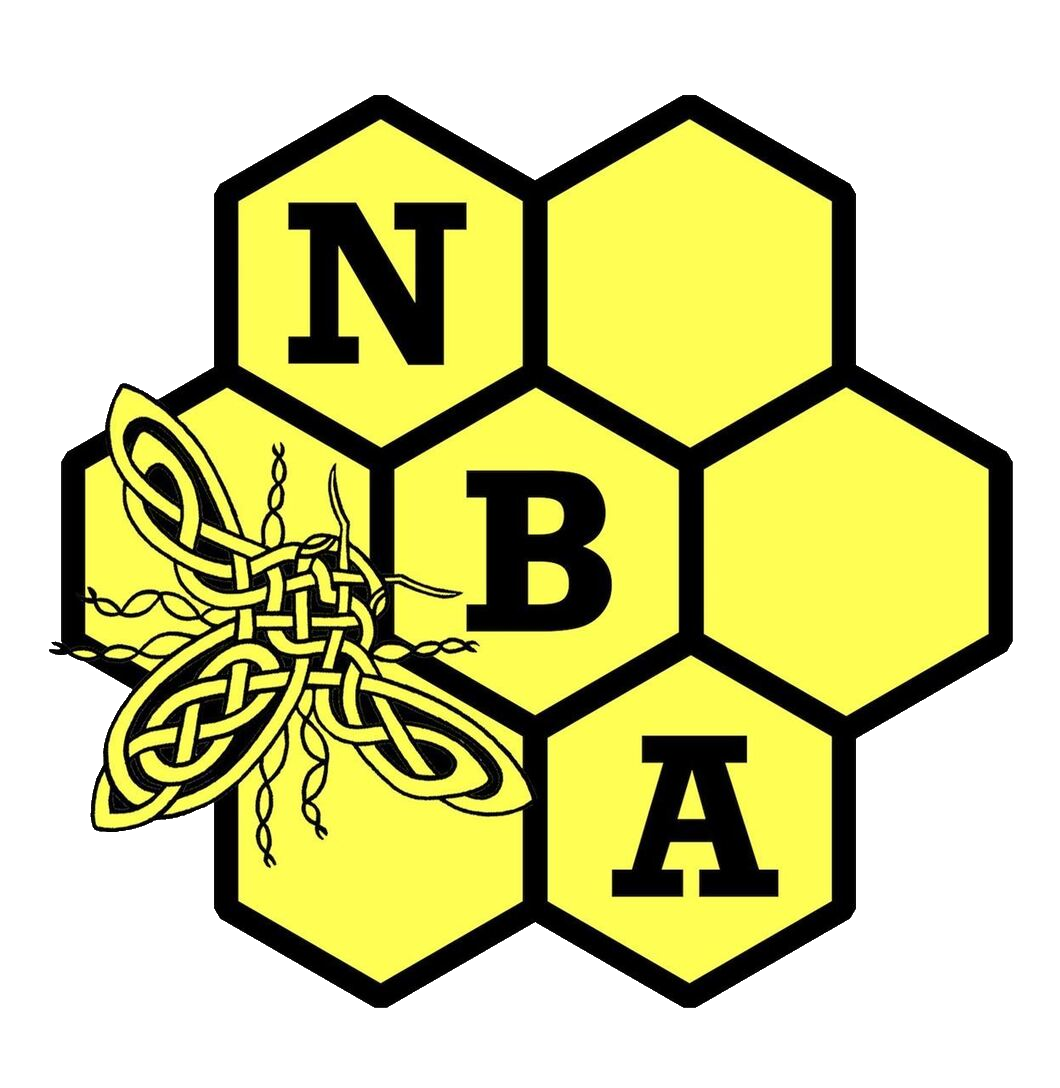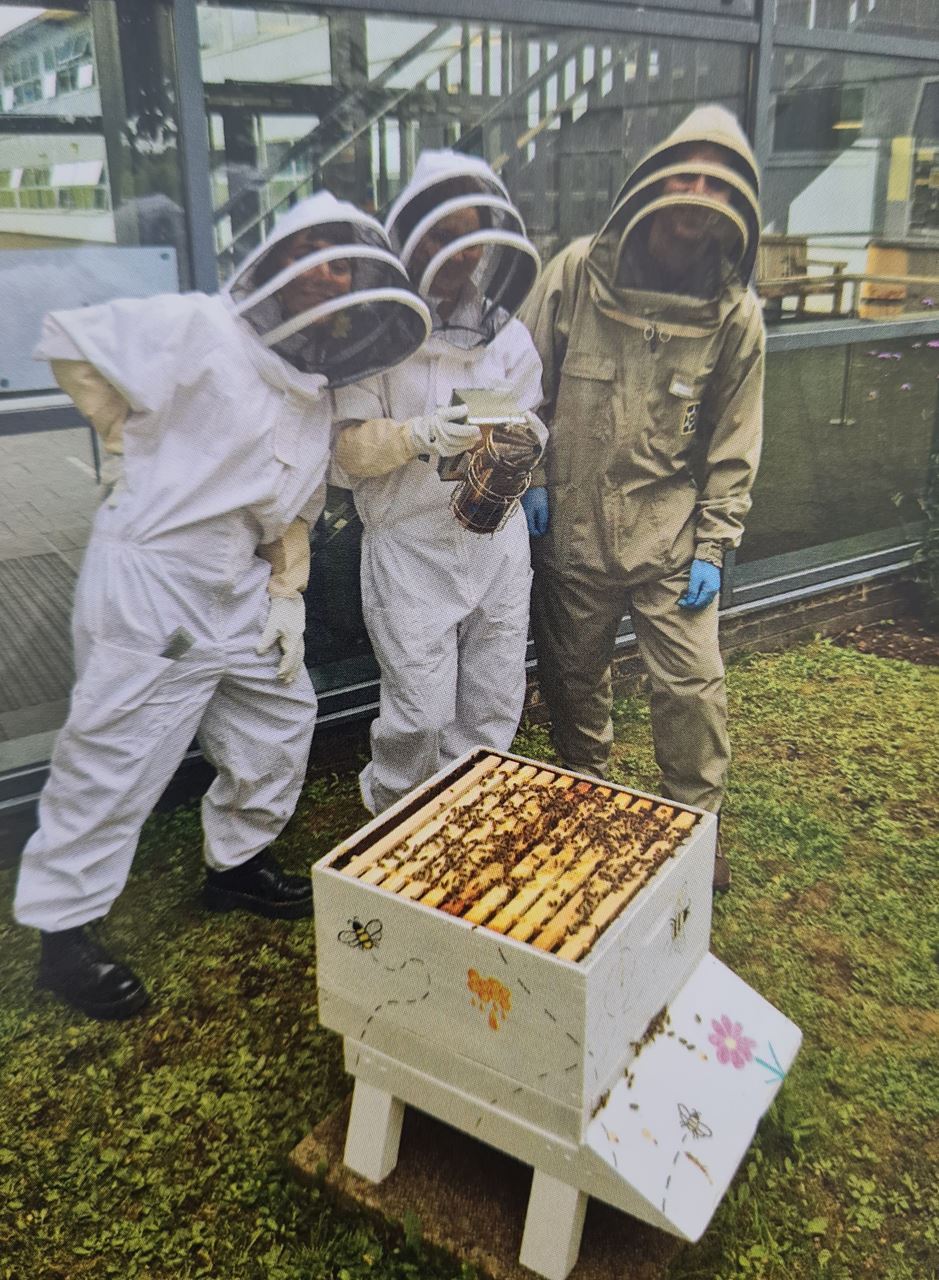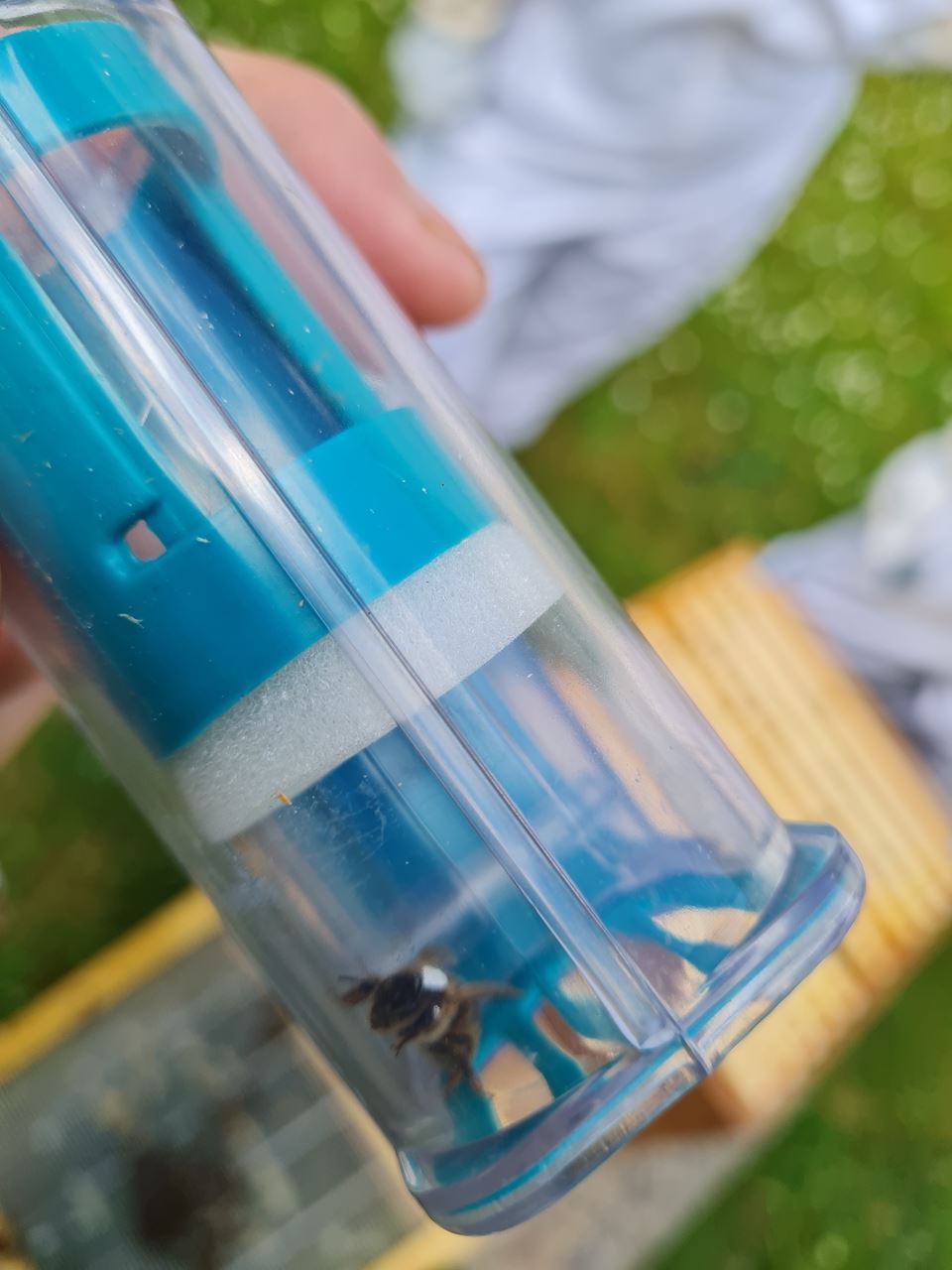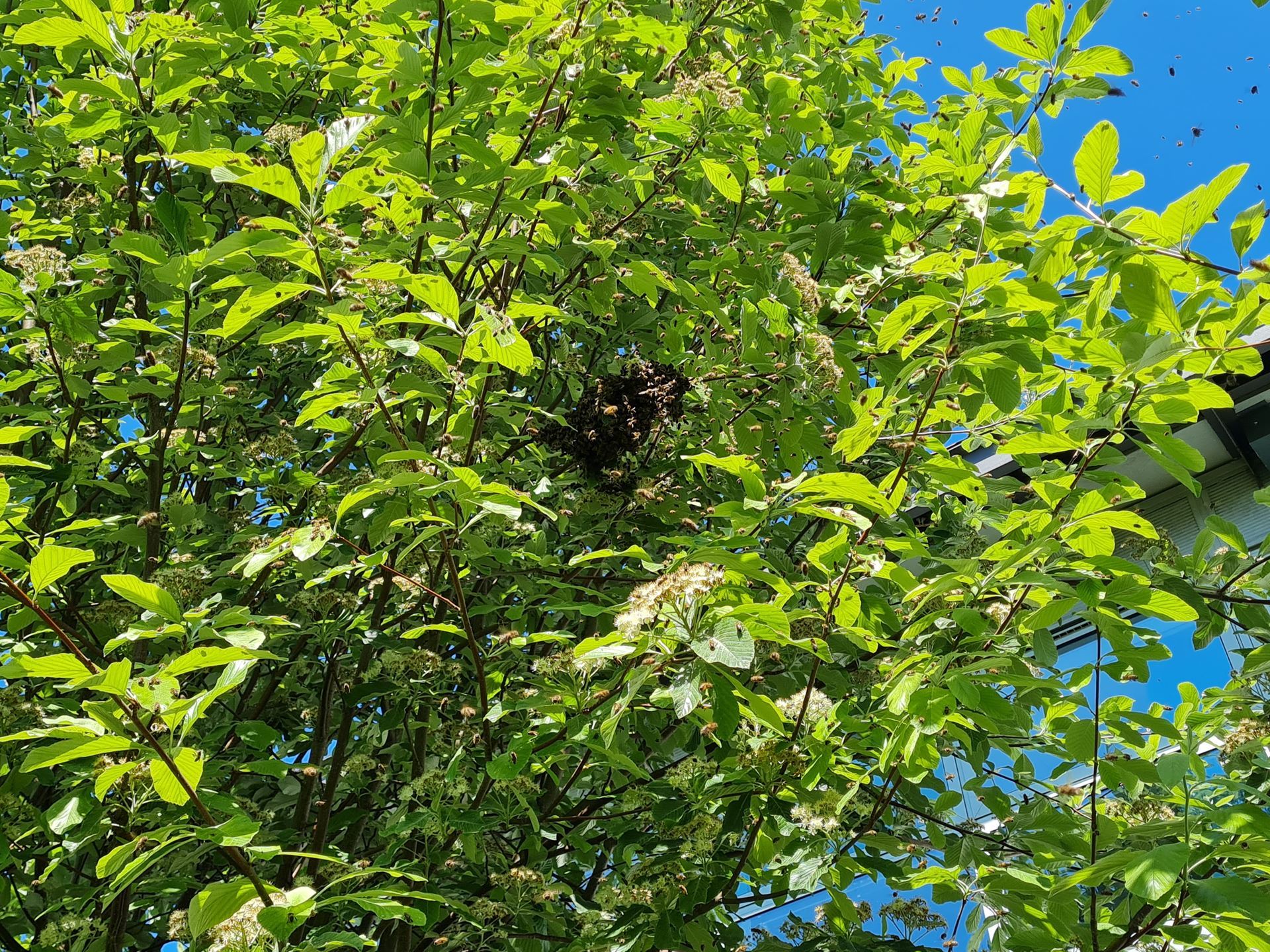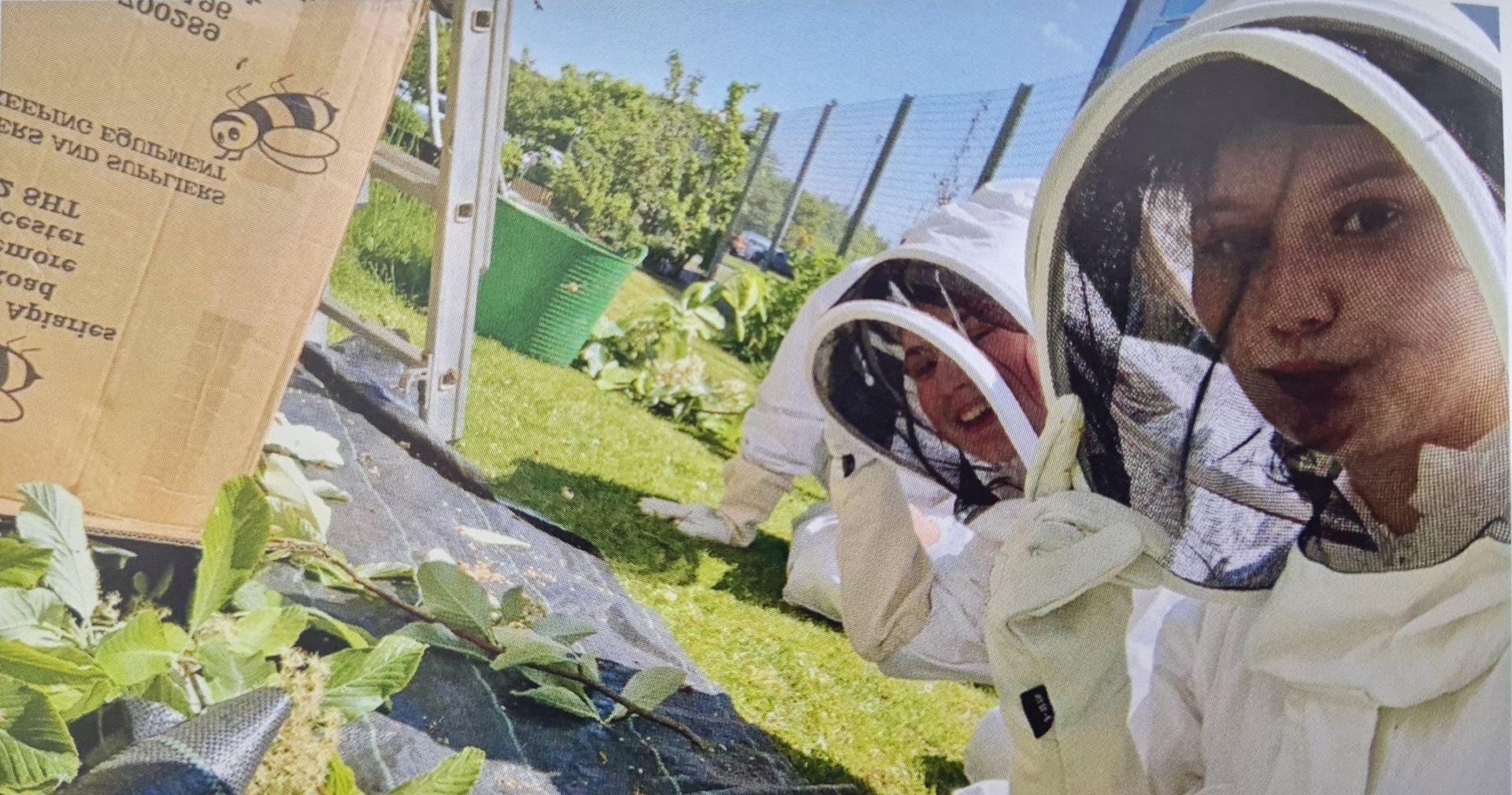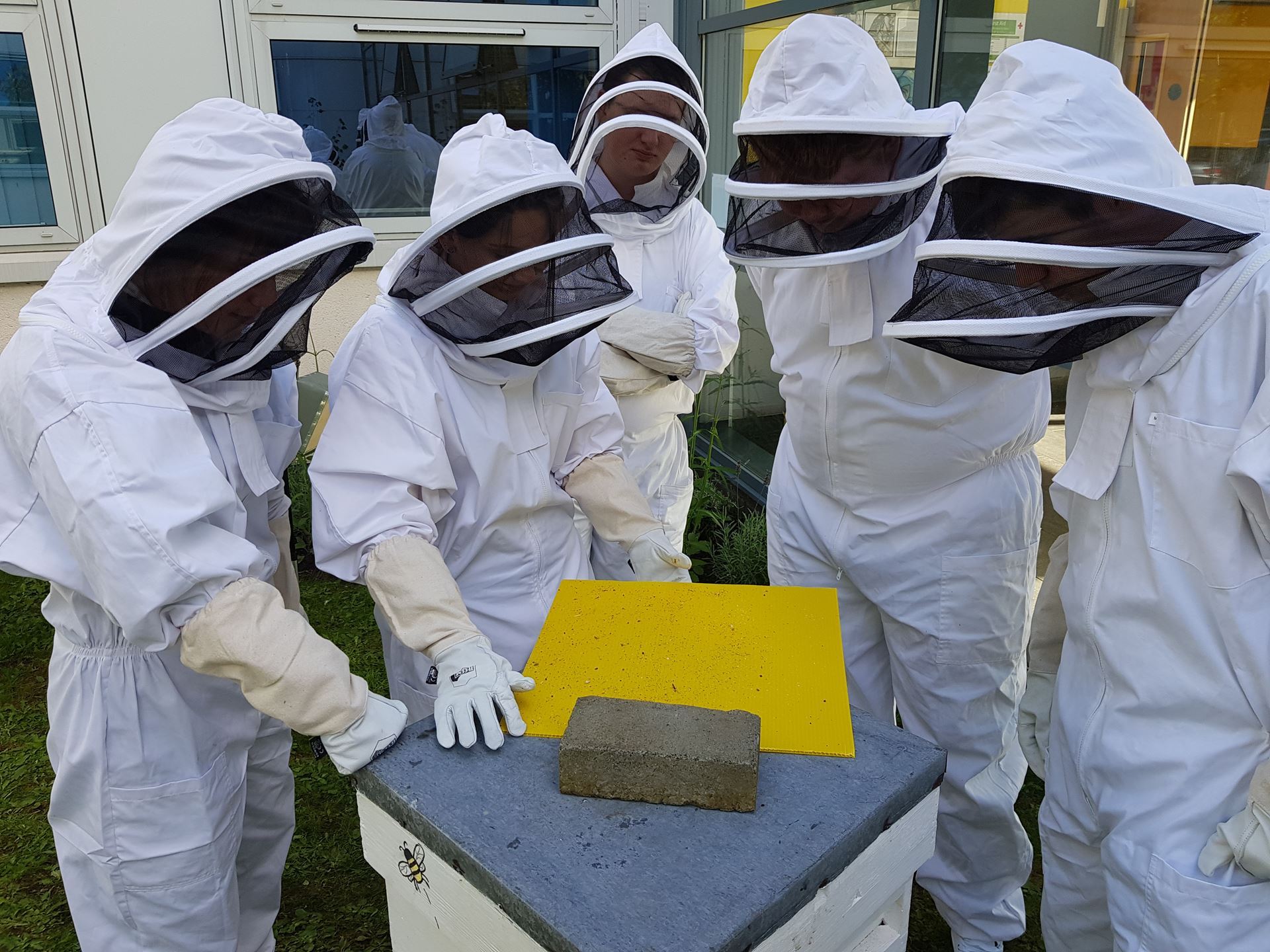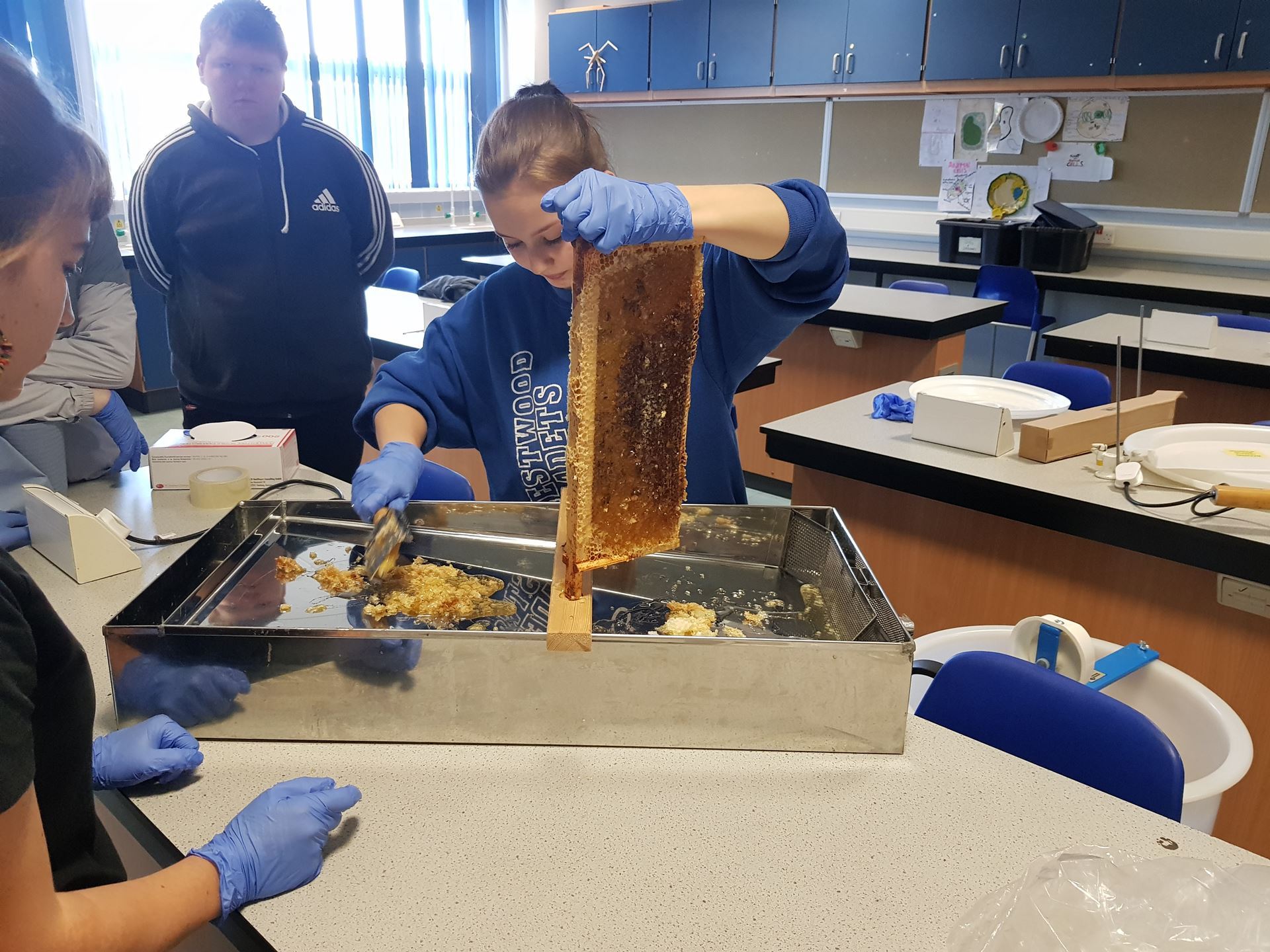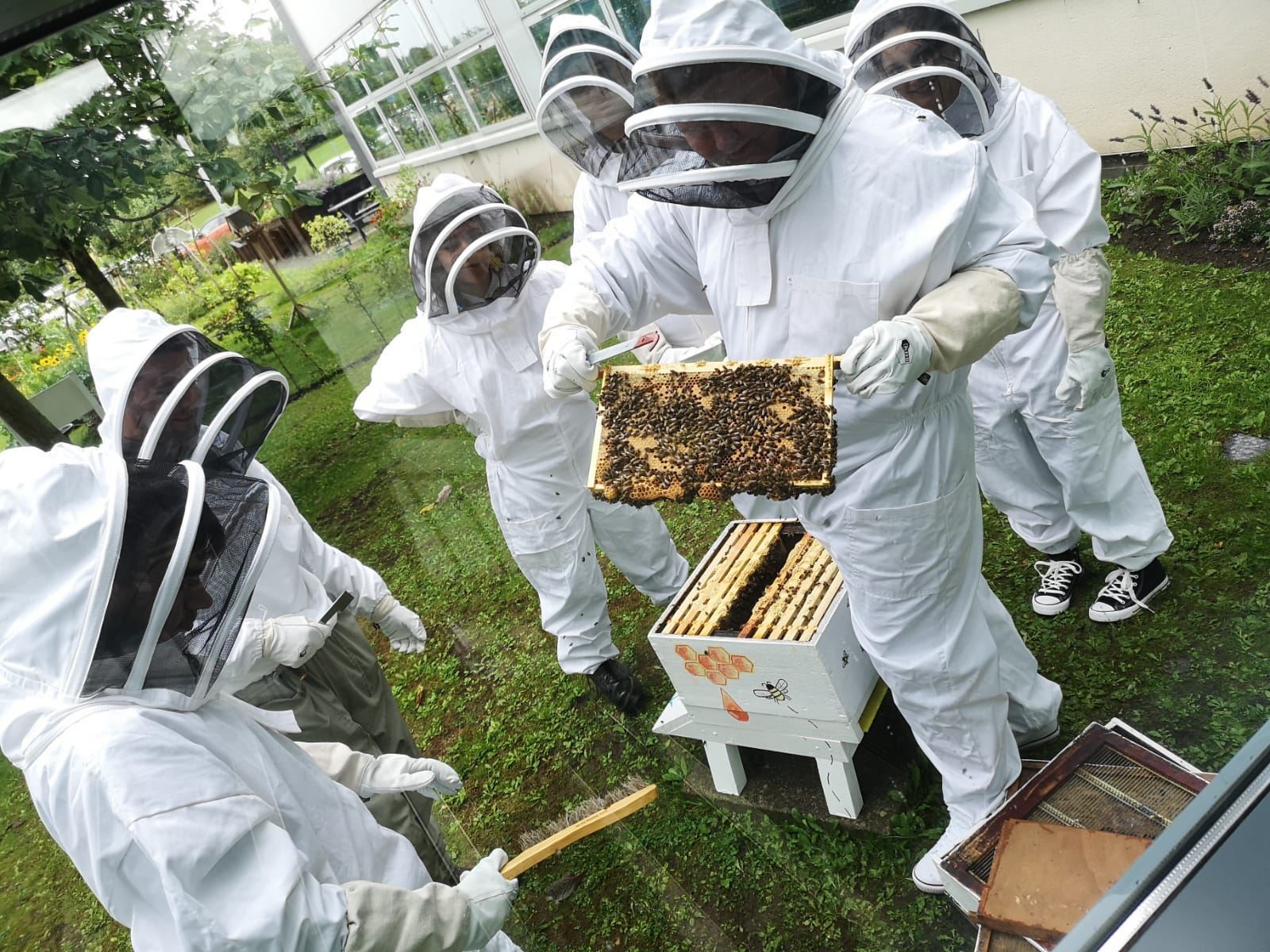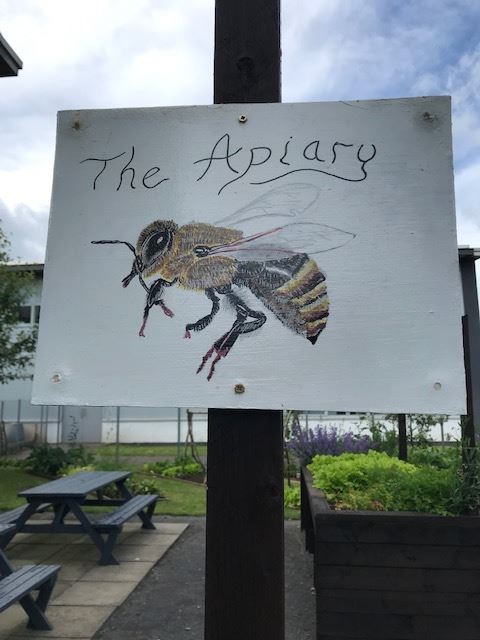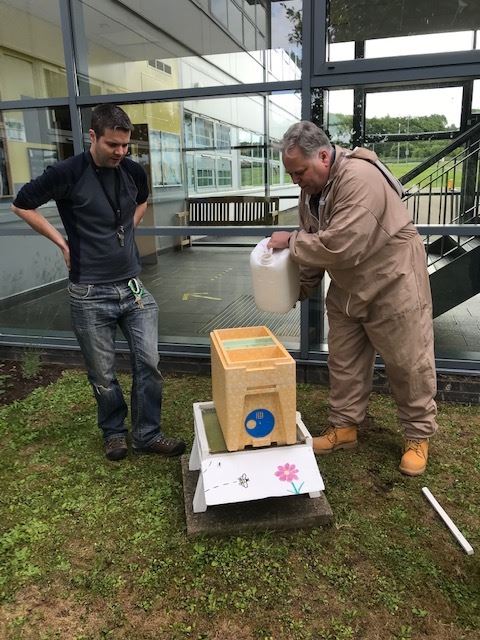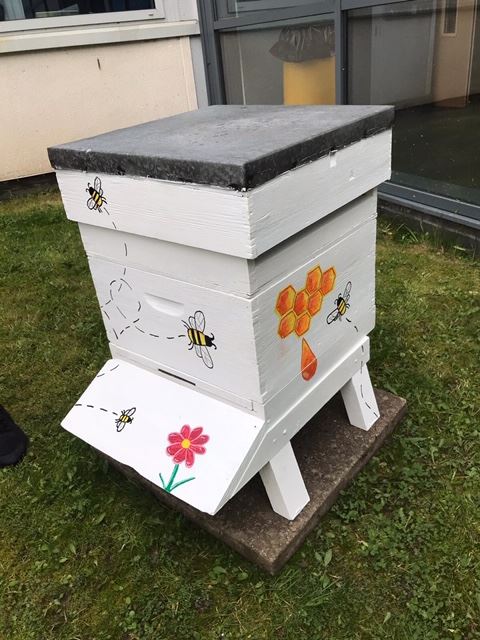DHS-Bee Project
Bees go back to School
|
Follow the progress of the school apiary along with the activities of the pupils involved with the project. The first bee colony took up residence on Saturday 18 July 2020 in a secure but very visible area of the school premises. Ross McGlade, already tasked with delivering the S3 horticulture programme took on the responsibility for coaching pupils through their Level 5 NPA in Beekeeping This page will tell their story. (the latest update is at the top of the page) |
18 July 2021 On this, the first anniversary of NBA presenting Dalkeith High School with our first nucleus colony of honeybees, it’s a good time to report on this year’s progress and the initial success of our project; a little piece of positivity in a year that has brought so much sorrow across the world.
|
Our first inspection of the season was carried out at the end of March and revealed the colony to be in fine health and building up well. Keeping them on a brood and a half over winter seemed to have done the trick and they had plenty of stores left over to see them through any patches of bad weather. Our queen had laid a small patch of brood in the super but we were able to find her quickly and get her back down in the brood box where she belonged. |
By the end of April the colony had expanded to the point that we needed to add a second brood box to provide room for the queen to lay in. Within a week the bees had drawn out all the frames bar one and the queen was laying in both boxes! Given how prolific she was, we knew that we’d have to be proactive in our swarm control and it was at this point that events took a farcical turn! By the end of the first week in May, the colony was ready to be split. Our second box was full of brood and contained the queen while the bottom box had brood in all stages and a number of open swarm cells. No problem we think, we’ll just take the box with the queen and plonk it on a new stand in the apiary, split the ample stores in the super between the two boxes and Bob’s your uncle, we should have two colonies in a matter of time. The bees had other plans however. |
|
| When we went back to our original box a few days later to reduce the number of queen cells, we found a number of sealed cells plus our original queen! We’re still not sure how she did it, but more than likely she simply flew/fell off the frame that she was on when we lifted the top box away. She’d never left the original colony at all! So, this left us with one hive containing our queen and sealed swarm cells and a second hive that was now full of sealed emergency swarm cells. Great. I did however manage to turn this into a salutary lesson for the class in how to behave in a measured way when confronted with a novel situation and despite all the books you’ve read, you’re not entirely sure what to do: I started panic dialling people in the NBA’s members directory and Ewan Mealyou made the mistake of answering! |
Ewan heroically rode to the rescue and made up a nuc containing our original queen and took it away to another apiary as our insurance policy and we reduced the number of queen cells in each of the remaining hives. By the end of the month I had continued to remove queen cells as the bees built more on the remaining eggs. This was where I made another mistake: if you’ve got a big colony with lots of field bees and you leave two queen cells (the one you want and one as a back-up) they’ll probably swarm. On the morning of 31st May, knowing it was going to be hot, I put signs up in the school asking anyone who saw clouds of bees heading up into the trees to come and get me ASAP. That afternoon several very excited S1s came running to my room to tell me that there “was something wrong with the bees” and that there were “billions” of them heading into the trees. A quick check revealed that they were indeed swarming. Great. So accompanied by Beth, Abby and Maya from the beekeeping class I went out to deal with the swarm. |
Standing in the middle of swarming bees is amazing and the noise and movement is pretty indescribable so we enjoyed the view, gave the bees a chance to settle on their chosen branch and figured out a plan. That plan involved the girls footing a substantial ladder while I teetered my way up into the canopy with a pair of loppers and a large box. What I could have done without was the large audience gathered at every classroom window surrounding the apiary and the dozens of mobile phones ready to capture me crashing to the ground! Unfortunately for those hoping for a viral video, a plan actually worked for once with the swarm dropping neatly into the box and after leaving it upturned on a groundsheet for a long enough period for them to settle, I poured them into a nuc box. At this point I need to thank Neil Rutherford for arriving with some spare brood frames and foundation because in hiving the nuc that Ewan had made up, I’d manage to use up all of my spare equipment, and also for once again allowing me to move this nuc to his apiary. |
|
| So how do things stand now? Well, having started the year with one colony at the school we now have three that are queenright and doing well and the swarm is almost okay; the virgin queen they swarmed on ended up poorly mated and began laying mixed patches of drone brood. The bees raised some supersedure queen cells in response, which at the time of writing they have voluntarily reduced to one, and so I’m just going to leave them alone other than keeping tabs on the weather and feeding them if need be. The class have all been awarded their NPA at level 5 by the SQA and some of them have continued to join me for inspections during the holidays and have even brought their parents along to join in. Zander, who has a real talent for beekeeping and who has read far beyond the requirements of the course in his own time, is looking to make a career out of this and is applying for apprenticeships with bee farmers. This has been particularly eye opening as despite the fact that demand for honey in the UK far outstrips supply, career opportunities are limited so if anyone reading this is in a position to offer keen young people an industry-based apprenticeship then please get in touch with me at the school or via NBA! As for next year, the one small class of six I began with this year has become two classes totalling thirty pupils next year and I have plans to use our third and fourth colonies for a junior beekeeping club and for our curricular Bronze Duke of Edinburgh’s Award group to learn beekeeping as the skill element of the award. Things certainly appear to be heading in the right direction! |
Finally, before I run down to the school to add another super to Hive 3, I’d like to say a few thanks to those that made this possible. Firstly, our head teacher Allyson Dobson whose idea this was originally. Too often in many schools, projects like this are started by staff who are sadly left to pour all their own time and resources into it but Allyson has ensured that the funding and support, particularly in ensuring this is a timetabled senior class, is there in spades and I cannot thank her enough for it. Secondly, I’d extend these sentiments to all at Newbattle Beekeepers Association. It is an extremely supportive and friendly community of people who have provided online lessons and meetings for those of us sitting our Basic Beekeepers Certificate this year when covid restrictions have prevented face to face teaching. I’ve benefitted from the experience and patience of so many people this year that it really is a salutary lesson for why anyone thinking of taking up beekeeping in any capacity should join their local association. Lastly I’d like to thank the pupils in my class this year for being who they are; I’ve had an absolute blast and I hope that you all manage to continue with your beekeeping in the future. Right, I’m off to add that super to Hive 3, oh yeah and that queen excluder on Hive 1 is a bit knackered and……….. |
|
Time To Reflect With summer now but a distant memory and our bees (we hope!) adequately prepared for the coming winter, all that remains to be done is reflect on what we’ve learned over the past few weeks. The class have become increasingly confident in their manipulations during our weekly inspections and are much more secure in making links between what they are seeing inside the hive and the theory they are studying in class. Everyone can light a smoker, use hive tools and talk their way through their actions frame by frame as they carry out an inspection even with the added pressure of an impressively sized audience watching from the glass wall directly behind the hive. |
|
| Thanks to Neil Rutherford, who very kindly gave us two of his full supers and a huge amount of equipment, we were able to meet the course outcome that requires candidates to extract and jar honey. This took us a full day and was easily both the most fun and most stressful part of the course so far. Everyone had great fun uncapping frames, spinning them in the extractor and then filtering the honey, the stress came from the clear up; cleaning equipment and work surfaces covered in honey is on a par with clearing up after environmental disasters! No matter how often we scrubbed and liberally applied kettle after kettle of boiling water, there was always a bit that we had missed. Still, it was a great day and I’m looking forward to extracting honey from our own colony (fingers crossed!) next year. |
Since then we have watched the hive fill up with stores as we fed generously over September and this has allowed the bees to draw out a full super’s worth of comb and fill it with stores which we’re leaving on over winter so they should have plenty to see them through. Mouse guards are in place, varroa strips have been added to the brood box and are due to come out in a couple of weeks and we’ve been reading and cleaning the varroa board each week and learning all we can from what it has to tell us. A sad pile of corpses below the alighting board last week let us know that the last of the drones had been expelled and with that final act the colony now seems ready for the cold dark ahead. The bees, with a little help from us, have done everything possible to ensure they’ll see the spring but as you will undoubtedly know it’s now in the lap of the gods. See you in the spring for another chapter in our story! |
|
The First Two Weeks
Like all other aspects of life in 2020, our August return to school has been far from normal: break and lunch times have been staggered, masks and bottles of hand sanitiser are ubiquitous but far more positively, our new colony of bees have proved to be something of a hit with many of our pupils who have kept me on my toes with a huge number of questions. Questions from staff have been no fewer in number but far more revealing; “Why have you got a box of wasps?” illustrating that for many of us, fat, fluffy bumblebees rather than Apis Mellifera is what the mind conjures when asked to describe a bee. My small class of budding beekeepers have taken to their new subject with great excitement, choosing to wear bee earrings and face masks as a very obvious sign of their enthusiasm. They were however less enthusiastic about my unimaginative choice of “Hive Number 1” when reading the inspection record cards I had completed over the summer and so they collectively decided to rebrand our colony “Buzzingham Palace.” Take a look at the residents of Buzzingham Palace |
Having spent a week on classroom instruction that covered the basics of equipment and what to expect on our first inspection, suits were donned, smokers were lit and the palace was cracked open to see what was going on inside. We went through each frame carefully and saw good signs of a healthy growing colony, although the first frame on which we found eggs had around five cells containing two eggs each which gave me a minor heart attack as all the nightmare scenarios rapidly played through my head – it’s getting late in the season, the queen is dead, we’ve got laying workers, the colony is doomed. Having voiced my concerns over these multiple eggs in a cell one of my pupils, Beth, pointed out that she’d been doing some reading the night before and had learned that laying workers would probably place far more than two eggs in each cell and they would be stuck to the sides. Given that this wasn’t the case, that we’d found far more normally laid eggs and that the rest of the colony seemed happy we concluded that this new queen might have just temporarily run out of laying space and that these five cells were an anomaly. We decided to put on a super seeing as space for stores and laying seemed to be getting tight and Beth’s reward for her eager engagement with the course was to have an exceptionally sneaky bee find a gap between her bee suit and her footwear and sting her on the ankle! To her eternal credit, she took this like an old sweat and has not allowed it to dampen her enthusiasm one jot, although she did resolve to wear boots from then on. Having shut the hive up and completed our record cards, the class awaited the following week’s inspection to see what might lie in store. | Week two’s inspection, despite a slightly overcast and threatening sky turned out to be a triumph. This time I took a backseat as the pupils took it in turn to use the smoker and remove and inspect a couple of frames each. The colony had further expanded with masses of brood in all stages, eggs were in abundance and there was only one in each cell (yes!) and the bees had started to draw out the comb on the super that we had added the previous week. Having been entranced by multiple baby bees chewing their way free from their cells, we thought that this would be the highlight of today’s visit to Buzzingham, but there was one further treat in store. Having evaded me for weeks, our unmarked queen decided to show herself on a frame with relatively few bees on it so we quickly trapped her in a cage and very delicately marked her thorax with a blue dot! By the time we closed up the hive and completed our record cards, the bees weren’t the only ones that were buzzing! |
| Where did the idea Come From? As with many good ideas, it started by pinching someone else’s! On an in-service day in October 2019, members of Dalkeith High School’s senior leadership team visited Kelso High School on an entirely unrelated matter and just happened to see a number of pupils turn up at school. The answer to why the kids had turned up was quite surprising: their beekeeping lessons happened to be on that day and they didn’t want to miss them even if the school was closed for staff training. Ray Baxter, a science teacher at the school had done such a good job at engaging his pupils with this rather more exotic subject, they were even prepared to give up their day off to participate – the teaching Holy Grail had been discovered! Our head teacher, Allyson Dobson recognised this as an opportunity to develop a subject that could really enthuse our pupils, help with our mission to deliver education in sustainability and further develop our provision of subjects with a practical, vocational focus. Seeing as I had already been tasked with delivering our S3 horticulture programme, Allyson asked if I fancied having a go at beekeeping and if I did, she knew just the man to help out: her friend Neil Rutherford. |
What happened Next? So it was that on 16th November I found myself in the fantastic environs of the Newbattle Bee Academy and meeting with Neil, David Hennessey, Ewan Mealyou and Maurice Gallagher. We discussed the aims of the project and possible ways that NBA could support the school and forge a lasting partnership that would be beneficial to both organisations. Neil, David and Ewan visited the proposed apiary site at the school and having judged it suitable, proposed that the association could assist with the provision of some equipment and a colony of bees. The only rather major problem remaining was that I knew absolutely nothing about beekeeping and so I joined NBA as a member and began studying for the Basic Beekeeping Certificate. |
|
“Buzzingham Palace.” | And Then? Over the winter I began renovating the rather dilapidated area that was to become the school’s apiary and met with Neil every Tuesday to go over the course materials and learn as much of the theory of beekeeping as possible. In early spring I felt like I was starting to make some discernible progress, the daytime temperatures had warmed up and Neil and I had organised our first visit to his hives at his own apiary so that I could begin my practical education, then Covid-19 reared its ugly head. Lockdown prevented any ‘hands-on’ education and so it was back to solo study of my books and using the time to rejuvenate the hive provided by the association and bring the apiary/garden site back to life. The association continued to provide fantastic support through online Zoom sessions including live hive inspections and other video support which has proved invaluable to us novices and with the easing of lockdown measures over the summer, Myriam and David created a fantastic nuc which was installed at the school on Saturday 18th July. I can happily report that the bees are ideally suited for school in that they are extraordinarily well-behaved (better than some of our pupils!) and have now drawn out the comb on all the frames in their new hive and the only real problem (at the time of writing) is that the queen is still evading my efforts to find and mark her. Undoubtedly one of the senior pupils who I shall be coaching through their Level 5 NPA in beekeeping will utterly shame me by spotting her on their very first inspection, but professional embarrassment by a particularly able pupil is a hazard that any teacher will be more than familiar with. Neil continues to mentor me with a great deal of patience and skill and I have, despite the tragic circumstances of 2020, enjoyed my early journeys into beekeeping and have nothing but the highest praise and admiration for everyone who has been involved in the project so far. Thank you all, and with Malcolm’s sterling web support I shall endeavour to keep you updated on the progress that I, my pupils and of course, the bees make in the future. |
